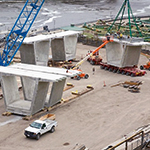| The market situation depends on the foreign investment flow |
| English Section 09 Feb 2011 08:00 |
 The depreciation of the main macroeconomic indicators, increased in the last quarter of 2009, will generate - at least in the next 6 months - a further activity drop on the national constructions market and the related sectors. Recently, the National Bank of Romania (BNR) officials have announced that, between January and November 2010, foreign direct investments (FDI) dropped by 25.58% as against the same period of 2009, down to EUR 2.269 billion (as against EUR 3.049 billion). Under these circumstances, the lack of financing, inefficient economic recovery government solutions, the blocking of credits and works for many specific projects (including as a result of their seasonal nature) will continue to generate an expansion of the market aggregation phenomenon, at the same time as a growth of competition and a continuation of the financial blockage (however, less than during the first two years of recession), and the companies not managing to control the resources necessary for survival will join those having already declared their insolvency. The depreciation of the main macroeconomic indicators, increased in the last quarter of 2009, will generate - at least in the next 6 months - a further activity drop on the national constructions market and the related sectors. Recently, the National Bank of Romania (BNR) officials have announced that, between January and November 2010, foreign direct investments (FDI) dropped by 25.58% as against the same period of 2009, down to EUR 2.269 billion (as against EUR 3.049 billion). Under these circumstances, the lack of financing, inefficient economic recovery government solutions, the blocking of credits and works for many specific projects (including as a result of their seasonal nature) will continue to generate an expansion of the market aggregation phenomenon, at the same time as a growth of competition and a continuation of the financial blockage (however, less than during the first two years of recession), and the companies not managing to control the resources necessary for survival will join those having already declared their insolvency. According to the BNR data, "foreign direct investments made in the first 11 months of 2010 were mainly generated by capital participations (consolidated with the net estimated loss), which totalled EUR 1.419 billion, the difference (EUR 850 million) representing intra-group credits (concluded between the foreign investor and the resident company)". We thus notice that big foreign companies with business in our country have considerably reduced their crediting lines, in favour of covering losses recorded on the local market. If we consider the extremely low level of such funds, we notice that, in terms of earmarking the amounts intended for real estate project development, the situation is dramatic. "In 2009, foreign direct investments dropped down to EUR 4.89 billion, indicating half of the value recorded in 2008 (EUR 9.5 billion), but covered 96.9% of the current account deficit. The current situation shows that the FDI share of current account financing dropped significantly during the first 11 months of 2010, when direct investments by non-residents in Romania barely covered 43.9% of the deficit", as also pointed out in the BNR analysis. This year, the FDI flow might continue to drop (less than in 2010), but even in case of stabilization, the timeframe required for arriving at the loss recovery period is increasingly longer. Most sector company managers have recently estimated that the second half of 2011 will be marked by a slight improvement of the factors influencing the economy, the construction market being to follow an ascending trend only in 2012.
Statistic indicators confirm the growth of the 2010 recession
The statistic data available for the first 11 months of 2010, as well as the main macroeconomic indicators confirm once again the serious situation having defined the constructions market and related sectors during the second year of recession. According to the most recent National Institute of Statistics (INS) report, between January and November 2010, the volume of construction works (as gross series) dropped by 15% as against the same period of 2009. "An analysis of the structure elements revealed a drop in the number of new construction works (-21.1%) and capital repair works (-8.6%), but in the case of maintenance and current repair operations, the respective indicator increased by 2.5%. In terms of construction items, we noticed a reduction in all situations, thus: residential buildings (-36.9%), non-residential buildings (-17.3%) and engineering constructions (-3.4%). As an adjusted series (according to the number of working days and the seasonal factor), we recorded a 15.1% drop, thus distributed: new construction works (-23.3%), respectively operations implying capital repairs (-12.7%). On the other hand, the volume of maintenance and capital repair works increased by 8.4%. As for construction items, the reductions calculated as an adjusted series were -37.4% for residential buildings, -19.2% for those with a destination other than dwelling unit and -2.9% for engineering constructions", as pointed out by an INS release. Basically, the analyzed timeframe was defined by a share of 85% of the activity volume recorded in the same timeframe of 2009 (also marked by an average 15% drop as against 2008). "In November 2010, the construction works volume dropped (as against October 2010), both in terms of gross series, and adjusted series, by 2.8%, respectively 4.6%. Considering a monthly comparison basis, the gross series drop mainly affected the maintenance and current repair works (-22.2%), while capital repair and new construction works recorded growths of 14.3%, respectively 3.9%. In terms of construction items, the specific indicator dropped in the case of engineering constructions (-14%). Growths were recorded with non-residential buildings and residential buildings, namely 21.1%, and respectively 12%. In November 2010, as against the previous month, a 4.6% index drop was recorded (adjusted series), a drop noticed in the case of maintenance and current repair works (-15.9%) and new construction works (-1.7%). The only growth was recorded by capital repair works (+9.1%). In terms of build units, we noticed a drop of engineering constructions (-15.2%). As for non-residential and residential buildings, the construction works volume grew by 10.3%, respectively 7.5%", as also shown by the INS release. It is clear that the market survival of many companies from the constructions branch and related sectors almost exclusively depends on maintenance and current repair works. Their volume increased significantly (in terms of share and importance) during the two years of recession, but the respective works’ relatively low value fails to generate a sufficient flow of liquidities for specialized companies. This basic market trend in 2010 might consolidate in 2011, to the detriment of most specialized companies, but it all depends on the way the foreign investment flow might change the share of each constructions category. The INS conjectural study published on 28 January 2011 forecasts an activity drop in the constructions sector and the retail trade field, the processing industry and services being defined by a relative stability, respectively a moderate decline. "The managers of the 8,478 companies having participated in the simple random stratified survey initiated by INS estimate on a short term - by March 2011 - a price growth in all national economy sectors, except for the constructions branch."Thus, for the timeframe January - March 2011, we can outline a relative stability of the processing industry activity, a moderate service drop, and a reduction of the constructions and retail trade sectors, as against the previous three months (according to the conjectural balance indicator)", as shown in another INS release. In the current situation, it is not surprising that over 1,671 construction sector managers - seriously affected by recession - count among the most pessimistic respondents. "According to the estimation from January 2011, in the following three months, the constructions sector will be defined by a drop in both the production volume (conjectural balance -24%), and the contracts and orders stock (conjectural balance -23%). This will have a major impact on the sector employees, particularly those of small companies, with up to 49 employees (conjectural balance -21%). At the same time, prices will follow a trend indicating a relative stability (conjectural balance +5%)", as also pointed out in the INS document. We need to mention that the conjectural balance indicates respondents’ perception of the dynamics of a phenomenon, but should not be mistaken for the growth or drop intensity of a statistic indicator value, as sustained by the INS specialists.
Article published in the January/February 2011 issue of the AGENDA CONSTRUCTIILOR Magazine. For detailed information click here!
|
ABONARE REVISTA (click aici): PROIECTE | INVESTITII | REVISTE | INDEX COMPANII
DATE DE CONTACT: Agenda Constructiilor & Fereastra - Tel/Fax: 021-336.04.16, 031-401.63.88




















































